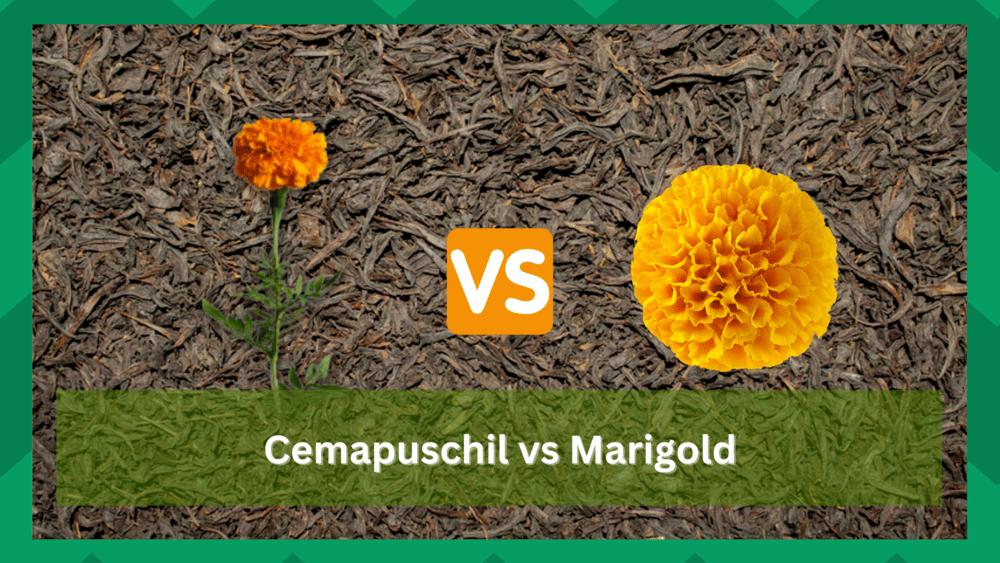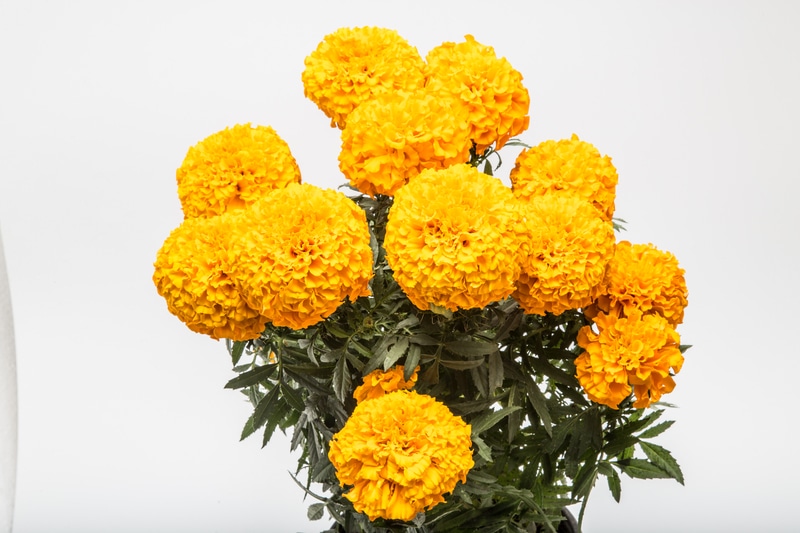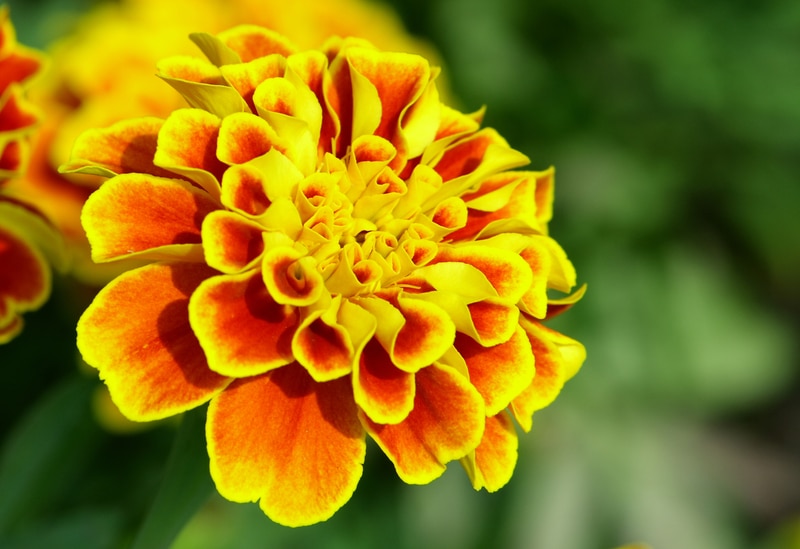
Tagetes is a genus of both annual and perennial flowers. The plant is from the family of Asteraceae, which is also commonly known as sunflowers. You should note that this plant has over species that all come with unique features.
Understanding their differences can help people decide which plants should be used in their gardens. Choosing from different colors, sizes, and fragrances can be good.
However, the steps required to keep the flowers healthy are another important thing that should be kept in mind. That said, cempasuchil and Marigold are plants that people often need clarification on.
Going through their specifications is necessary if you are thinking about planting one of these in your garden.
This is why we will use this article to provide you with a comparison and relevant information regarding the two plants.
Cempasuchil vs Marigold
| Cempasuchil | Marigold | |
| Type | Flowering plants | Flowering plants and shrubs |
| Origin | Mexican, Central America, South America | Mexico, central America |
| Habitat | Cultivated beds | Roadsides |
| Leaf shape | Pinnate | Toothed |
| Water requirement | Regular | Moist ground but not water logging |
Cempasuchil
The Cempasuchil, or Mexican marigold flower, is an important part of Mexico’s Day of the Dead celebrations.
It is believed that when these bright yellow and orange flowers are placed on altars and gravesites, they help guide the souls of deceased loved ones back to their families for a day.
The petals of this flower also have healing properties that can be used to treat fevers and headaches. Not only does it play a role in spiritual ceremonies but it has medicinal uses as well.
In addition to its traditional significance, this beautiful bloom has become increasingly popular among gardeners due to its vibrant colors and easy-to-care-for nature.
It’s no wonder why so many people cultivate these cheerful blooms.
Cempasuchil is an ancient flower native to Mexico and Central America, traditionally used for its medicinal properties.
It has a unique shape with five petals that bloom in the fall and winter months. The flowers have a strong scent which can be described as sweet, spicy, or pungent, depending on your taste.
Cempasuchil is used as decorations during festivals such as Dia de los Muertos (Day of the Dead). In addition to its ornamental value, cempasuchil has many practical uses in gardening and farming.
It requires full sun exposure and well-drained soil to thrive. Planting should be done at least 6 inches deep into the ground to establish roots before blooming begins.
Harvesting should occur once all petals have opened up fully; otherwise, they will not retain their color or fragrance properly.
To increase yield, fertilizing every few weeks with organic compost is recommended as regular pruning of dead leaves and stems throughout the growing season.
An advantage to growing cempasuchil is that it’s relatively pest-free and doesn’t require a lot of maintenance.
The medicinal properties of cempasuchil are well documented. Flowers, leaves, and stems have been used to treat various ailments such as colds, headaches, stomachaches, and even fever.
It is believed that cempasuchil can help reduce inflammation and pain and promote healing when used in a topical salve or balm.
Cultivating cempasuchil is simple; you can find ready-to-plant bulbs at most garden centers or online. With a little effort and care, you can soon have a garden full of these vibrant and fragrant flowers.
This is a variety of marigolds that are classified under larger flower types. This is because the plant grows huge flowers that come in different color options that you can select from. These can range from orange and yellow hues, giving your garden a unique look.
The flowers are mostly used in Mexico as a symbol of an annual holiday celebrating and honoring people who have departed.
These flowers are also sometimes referred to as flowers of the dead. This is because the flowers from this plant are said to attract the souls of people to the alters that these have been placed in.
The flower also shares some characteristics with other types of marigolds which is why it is often confused with African marigolds.
However, you should note that the plant is completely different as cempasuchil is only found in Central America and Mexico.
The plant usually grows in warm temperatures, which is why it can be planted in most gardens. Additionally, these can be grown as annual flowers if you can keep them in a spot where the temperature stays high and the flowers get direct contact with sunlight.
Growing and keeping cempasuchil healthy is simple as the plant is easy to maintain. It requires no maintenance as long as it is planted in an optimal location.
The flowers also give off a unique fragrance that is quite sweet and different from other marigolds species.
Marigold
Marigolds have several species, out of which cempasuchil is a famous one. This is why comparing the two plants can be a little difficult.
Although, if you look at the characteristics of the flower, then you will notice that some varieties of marigolds have several color options that you can select from. These can vary from peach, pink, yellow, and even orange shades.
Some types also have combinations of colors which make them look even better.
Other than this, another difference is that the odor on most marigolds is quite strong. This is great as it keeps animals and insects away from your garden.
The strong odor also acts as a pest repellent which is why marigolds are often grown as companion plants and harvest crops.
The Marigold is a beautiful and versatile flower used for centuries in gardens across the globe.
It’s easy to grow, drought tolerant, and produces an abundance of vibrant yellow, orange or red blooms throughout the growing season.
Taking proper care of your Marigold plants will ensure they produce more flowers and have a longer life span.
To maximize your yield and get the best out of this amazing flower, it is important to understand when to harvest them and how to keep them healthy. Here are some tips on taking care of Marigolds so you can enjoy their bounty for many years!
Taking care of Marigold is relatively easy. It requires well-drained soil, which means it should be planted in a location with plenty of sunshine and water.
The flower should be watered at least once a week, but if the weather is especially dry, two or three waterings per week may be necessary. Fertilizer should be applied every two to four weeks, and the soil should be kept free of weeds.
Marigolds can be harvested whenever the petals are dry and brittle. To increase yield, deadheading is recommended during the growing season, meaning removing old blooms before they produce seeds.
Pinching off the tops of the plants will encourage bushier growth and more flowers. Finally, Marigolds should be divided every 2-3 years to ensure healthy growth.
The Marigold can easily bring many years of beauty to your garden with proper care and maintenance.
The best time to harvest Marigold flowers is when they are fully open, and the petals are at their fullest. This will give you the most vibrant blooms and the longest-lasting bouquet.
If you wait too long, the petals may wilt and die before you can enjoy them. You can also harvest the buds before they bloom, but be sure to harvest them while they are still soft and pliable.
Marigolds prefer light and well-drained soil with a pH between 6.0 and 7.5. Avoid heavy clay or soggy soils, which may leave your plant prone to root rot. Mulch around marigolds to help retain moisture and keep weeds at bay.
Marigolds will benefit from an all-purpose, slow-release fertilizer such as a 10-10-10 blend applied in the early spring and mid-summer.
You can also supplement with compost or a liquid fertilizer every couple weeks during the growing season.
Maintain moderate watering levels for your Marigolds. Too much water can lead to root rot, while too little will stunt growth and reduce flowering potential.
Aim for an inch of water per week and adjust accordingly depending on weather conditions and soil type.
If you are thinking about growing potato or tomato plants in your garden, the marigolds can keep them healthy by attracting insects that will be useful for them.
Also, any insects or animals that are dangerous to the plant will either be kept away or attracted to marigolds instead. Moreover, some marigold flowers have edible flowers that can be used in salads.
You can even grind these to easily make food colors at your home. The only major similarity between all the varieties is how to maintain them.
Marigolds only require fertilizers while the plant is still growing. Once the flowers start blooming, people can leave the plant and only have to keep the soil around it moist.
This is enough to ensure that your marigolds will keep growing new flowers throughout the season.
Going through the information provided above, people can easily understand how the cempasuchil variety of marigolds differs from other species.




